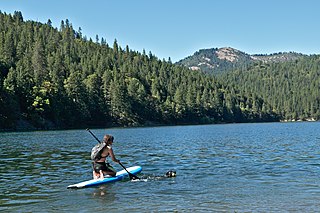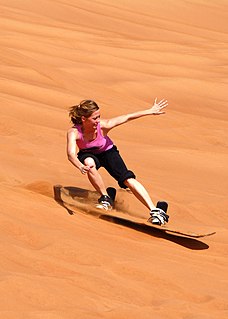 W
WAquaplaning is a surface water sport which involves riding a board (aquaplane) over the surface of a body of water towed behind a motorboat.
 W
WBailing is the process of falling off a board, losing control of the board while performing a trick in the air, or when the board hits the ground on the deck and not the wheels. Bailing can sometimes result in some type of injury.
 W
WA balance board is a device used as a circus skill, for recreation, balance training, athletic training, brain development, therapy, musical training and other kinds of personal development.
 W
WDirtsurfing is the sport of riding a Dirtsurfer brand inline board. This new Australian boardsport is correctly known as inline boarding because Dirtsurfer is a trademark protected brand name.
 W
WFlowriding is a late-20th century alternative boardsport incorporating elements of surfing, bodyboarding, skateboarding, skimboarding, snowboarding and wakeboarding. Flowriding takes place on an artificial wave called the FlowRider or the FlowBarrel. These waves were created by Wave Loch.
 W
WThe following is a list of surface water sports. These are sports which are performed atop a body of water.
 W
WKite landboarding, also known as land kiteboarding or flyboarding, is based on the sport of kitesurfing, where a rider on a surf-style board is pulled over water by a kite. Kite landboarding involves the use of a mountain board or landboard, which is essentially an oversized skateboard with large pneumatic wheels and foot-straps. Kite landboarding is a growing sport, and there are several competitions. Kite landboarding is attracting growing publicity although it is not yet as popular or as well known as kitesurfing.
 W
WKiteboarding or kitesurfing is an extreme sport where the kiter uses the wind power with a large power kite to be pulled on a water, land or snow surface. It combines aspects of paragliding, surfing, windsurfing, skateboarding, snowboarding and wakeboarding. Kiteboarding is among the less expensive and the more convenient of the sailing sports.
 W
WKneeboarding is an aquatic sport where the participant is towed on a buoyant, convex, and hydrodynamically shaped board at a planing speed, most often behind a motorboat. Kneeboarding on a surf style board with fin(s) is also done in waves at the beach. In the usual configuration of a tow-sport kneeboard, riders kneel on their heels on the board, and secure themselves to the deck with an adjustable Velcro strap over their thighs. Most water ski kneeboards do not have fins to allow for easier surface spins. As in wakeboarding or water skiing, the rider hangs onto a tow-rope. The advantages of kneeboarding versus other tow-sports seems to be an easier learning curve and a sense of being closer to the water when falls occur.
 W
WLand windsurfing, also known as “Terrasailing”, “street sailing”, “land sailing” and “dirt windsurfing”, is a sport similar to traditional windsurfing that is performed on land rather than water. A four wheeled deck, similar to a mountain board or skateboard deck, is commonly used in conjunction with a mast and sail in order to project the board across land.
 W
WLongboarding is riding on a longboard. Longboards vary in shape and size. Compared to skateboards, longboards are more stable, and have more traction and durability due to larger wheel size and lower wheel durometers. Generally, a skateboard comes in between 28-34 inches long and 7-10 inches wide, while a longboard has a length of 35-60 inches and a width of 9-10 inches. Many longboards use trucks (axles) that have different geometric parameters than skateboards. There are a variety of longboard disciplines, and types of longboards. Longboarding has competitive races down hill where riders can reach speeds exceeding 60 mph (97 km/h). The wider turning radius of longboards, as well as their ability to coast long distances make them more suitable for cruising and commuting on streets than regular skateboards.
 W
WMountainboarding, also known as Dirtboarding, Offroad Boarding, and All-Terrain Boarding (ATB), is a well established if little-known action sport, derived from snowboarding. This was initially pioneered by James Stanley during a visit in the 1900s to the Matterhorn where snow was not available. A mountainboard is made up of components including a deck, bindings to secure the rider to the deck, four wheels with pneumatic tires, and two steering mechanisms known as trucks. Mountainboarders, also known as riders, ride specifically designed boardercross tracks, slopestyle parks, grass hills, woodlands, gravel tracks, streets, skateparks, ski resorts, BMX courses and mountain bike trails. It is this ability to ride such a variety of terrain that makes mountainboarding different from other board sports.
 W
WOnewheel is a self-balancing single wheel electric board-sport, recreational personal transporter, often described as an electric skateboard. Unlike the electric unicycle, the riders feet are typically pointed at a perpendicular angle to the wheel and direction of travel.
 W
WPaddleboarding is a water sport in which participants are propelled by a swimming motion using their arms while lying or kneeling on a paddleboard or surfboard in the ocean. This article refers to traditional prone or kneeling paddleboarding. A derivative of paddleboarding is stand up paddleboarding also called stand up paddle surfing. Paddleboarding is usually performed in the open ocean, with the participant paddling and surfing unbroken swells to cross between islands or journey from one coastal area to another.
 W
WRiverboarding is a boardsport in which the participant lies prone on their board with fins on their feet for propulsion and steering. This sport is also known as hydrospeed in Europe and as riverboarding or white-water sledging in New Zealand, depending on the type of board used. Riverboarding includes commercial, recreational and the swiftwater rescue practice of using a high-flotation riverboard, designed for buoyancy in highly aerated water.
 W
WSandboarding is a boardsport and extreme sport similar to snowboarding that involves riding across or down a sand dune while standing on a board, either with both feet strapped in or while standing loose, without bindings. Sandboarding can also be practised sitting down or lying on the belly or the back. It typically involves a sandboard, although it is also possible to use sleds, surfboards, a skateboard deck, or snowboards.
 W
WSkimboarding or skimming is a boardsport in which a skimboard is used to glide across the water's surface to meet an incoming breaking wave, and ride it back to shore. Wave-riding skimboarders perform a variety of surface and air maneuvers, at various stages of their ride, out to, and back with, the wave. Some of these are known as "wraps," "big spins," "360 shove-its" and "180s." Unlike surfing, skimboarding begins on the beach by dropping the board onto the thin wash of previous waves. Skimboarders use their momentum to skim out to breaking waves, which they then catch back into shore in a manner similar to surfing.
 W
WSky surfing is a type of skydiving and extreme sport in which the skydiver wears a custom skysurf board attached to the feet and performs surfing-style aerobatics during freefall.
 W
WSnowboarding is a recreational and competitive activity that involves descending a snow-covered slope while standing on a snowboard that is almost always attached to a rider's feet. It features in the Winter Olympic Games and Winter Paralympic Games.
 W
WSnowkiting or kite skiing is an outdoor winter sport where people use kite power to glide on snow or ice. The skier uses a kite to give them power over large jumps. The sport is similar to water-based kiteboarding, but with the footwear used in snowboarding or skiing. The principles of using the kite are the same, but in different terrain. In the early days of snowkiting, foil kites were the most common type; nowadays many kiteboarders use inflatable kites. However, since 2013, newly developed racing foil kites seem to dominate speed races and expedition races, like Red Bull Ragnarok and the Vake mini-expedition race. Snowkiting differs from other alpine sports in that it is possible for the snowkiter to travel uphill and downhill with any wind direction. Like kiteboarding, snowkiting can be very hazardous and should be learned and practiced with care. Snowkiting is becoming increasingly popular in places often associated with skiing and snowboarding, such as Russia, Canada, Iceland, France, Switzerland, Austria, Norway, Sweden, Finland and the Northern and Central United States. The sport is becoming more diverse as adventurers use kites to travel great distances and sports enthusiasts push the boundaries of freestyle, big air, speed and back country exploration.
 W
WA snowskate is a hybrid of a skateboard and a snowboard, intended primarily to allow for skateboard-style tricks on the snow. There are many types depending on the brand or style of snowskate.
 W
WStandup paddleboarding (SUP) is a water sport born from surfing with modern roots in Hawaii. Stand up paddle boarders stand on boards that are floating on the water, and use a paddle to propel themselves through the water. The sport was documented in a 2013 report that identified it as the outdoor sporting activity with the most first-time participants in the United States that year. Variations include flat water paddling, racing, surfing, whitewater SUP, yoga, and fishing.
 W
WStreet luge is an extreme gravity-powered activity that involves riding a street luge board down a paved road or course. Street luge is also known as land luge or road luge. Like skateboarding, street luge is often done for sport and for recreation.
 W
WSurfing is a surface water sport in which an individual, a surfer, uses a board to ride on the forward section, or face, of a moving wave of water, which usually carries the surfer towards the shore. Waves suitable for surfing are primarily found on ocean shores, but can also be found in standing waves in the open ocean, in lakes, in rivers in the form of a tidal bore, or in wave pools.
 W
WVolcano surfing or volcano boarding is a sport performed on the slopes of a volcano. One of the most popular places for the activity is the Cerro Negro near Leon in western Nicaragua. Riders hike up the volcano and slide down, sitting or standing, on a thin plywood or metal board. The sport is also practiced on Mount Yasur on Tanna, Vanuatu, and Mount Bromo in Indonesia.
 W
WWakeboarding is a water sport in which the rider, standing on a wakeboard, is towed behind a motorboat across its wake and especially up off the crest in order to perform aerial maneuvers. A hallmark of wakeboarding is the attempted performance of midair tricks. Wakeboarding was developed from a combination of water skiing, snowboarding and surfing techniques.
 W
WWakeskating is a water sport and an adaptation of wakeboarding that employs a similar design of board manufactured from maple or fibreglass. Unlike wakeboarding, the rider is not bound to the board in any way, similar to the skateboard, from which the name derives.
 W
WWakesurfing is a water sport in which a rider trails behind a boat, riding the boat's wake without being directly pulled by the boat. After getting up on the wake, typically by use of a tow rope, the wakesurfers will drop the rope, and ride the steep face below the wave's peak in a fashion reminiscent of surfing. Wakesurfers generally use special boards, designed specifically for wakes.
 W
WWindsurfing is a surface water sport that is a combination of surfing and sailing. It is also referred to as "sailboarding" and "boardsailing", and emerged in the late 1960s from the surf culture of California. Windsurfing had gained a following across North America by the late 1970s and had achieved significant global popularity by the 1980s.